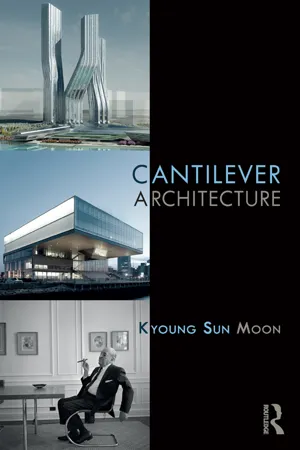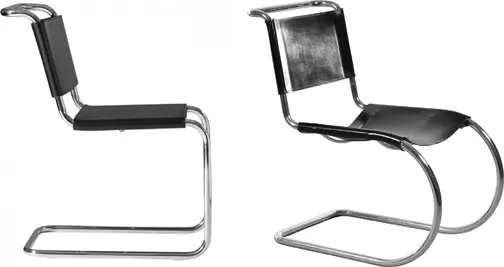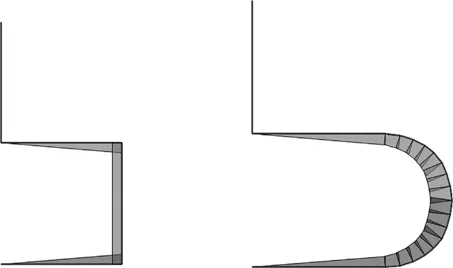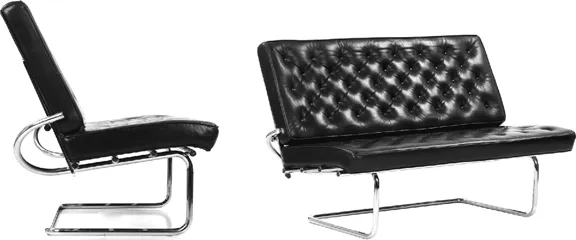
- 266 pages
- English
- ePUB (mobile friendly)
- Available on iOS & Android
eBook - ePub
Cantilever Architecture
About this book
Cantilever Architecture shows you how to integrate cantilever designs into your building from conception, to help you create support-free structures without the need for columns or walls, whether for balconies, stairs, to occupy the air rights of the lot next door, or to build super tall buildings. The book includes 78 built case studies in 22 countries on 5 continents to illustrate various systems and their load carrying mechanisms at different scales. Includes an appendix on cantilevered furniture and more than 240 black and white images.
Frequently asked questions
Yes, you can cancel anytime from the Subscription tab in your account settings on the Perlego website. Your subscription will stay active until the end of your current billing period. Learn how to cancel your subscription.
At the moment all of our mobile-responsive ePub books are available to download via the app. Most of our PDFs are also available to download and we're working on making the final remaining ones downloadable now. Learn more here.
Perlego offers two plans: Essential and Complete
- Essential is ideal for learners and professionals who enjoy exploring a wide range of subjects. Access the Essential Library with 800,000+ trusted titles and best-sellers across business, personal growth, and the humanities. Includes unlimited reading time and Standard Read Aloud voice.
- Complete: Perfect for advanced learners and researchers needing full, unrestricted access. Unlock 1.4M+ books across hundreds of subjects, including academic and specialized titles. The Complete Plan also includes advanced features like Premium Read Aloud and Research Assistant.
We are an online textbook subscription service, where you can get access to an entire online library for less than the price of a single book per month. With over 1 million books across 1000+ topics, we’ve got you covered! Learn more here.
Look out for the read-aloud symbol on your next book to see if you can listen to it. The read-aloud tool reads text aloud for you, highlighting the text as it is being read. You can pause it, speed it up and slow it down. Learn more here.
Yes! You can use the Perlego app on both iOS or Android devices to read anytime, anywhere — even offline. Perfect for commutes or when you’re on the go.
Please note we cannot support devices running on iOS 13 and Android 7 or earlier. Learn more about using the app.
Please note we cannot support devices running on iOS 13 and Android 7 or earlier. Learn more about using the app.
Yes, you can access Cantilever Architecture by Kyoung Sun Moon in PDF and/or ePUB format, as well as other popular books in Architektur & Architektur Allgemein. We have over one million books available in our catalogue for you to explore.
Information
PART 1
HORIZONTAL CANTILEVERS
CHAPTER 1
CANTILEVERED FURNITURE
FURNITURE PERFORMS AS A VERY IMPORTANT integral part of interior space. Many architects have been fascinated by the idea of designing customized furniture for their own designed buildings. Frank Lloyd Wright, one of the greatest architects of all time, designed furniture as unified components of his architecture. He customized this furniture for many of his designed buildings to integrate the design of the entire building as a whole. For many early modernism architects, it was almost necessary to design furniture for their own buildings because of the stylistic lag in traditional furniture design compared to the buildings they designed with new materials, technology and design ideas. Though the early modernists, such as Ludwig Mies van der Rohe, Le Corbusier, Alva Alto and Marcel Breuer, to name a few, initially designed furniture mostly for their own designed buildings, their furniture was typically intended to be mass-produced by machines as well.
Cantilevered chairs, as a pioneer of employing the principle of significantly proportioned cantilever in furniture, were brought to the world in this context. The concept of cantilever has a long history in architecture with smaller scales and proportions in the past with the use of traditional building materials such as stone and wood. Cantilevers of significant proportions only became possible with stronger and stiffer modern structural materials such as steel and reinforced concrete. In furniture design, the inspiring initial use of tubular steel by Marcel Breuer and the original cantilevered frame designed for a chair by Mart Stam using gas pipes in the 1920s were put together to produce the early versions of cantilever chairs and numerous variations soon after. Since then, the cantilever chair using tubular steel and later on other materials, has become a very important category of contemporary chairs.
This chapter presents how cantilevered furniture, such as cantilevered chairs and tables work structurally and what the performance differences are between cantilevered and non-cantilevered furniture. Further, cantilevered furniture items of various configurations are comparatively studied with real world examples designed by architects and designers, such as Mart Stam, Mies van der Rohe, Marcel Breuer, Garrit Rietveld, Eileen Grey, to name but a few.
1.1 CANTILEVER CHAIRS
Chairs, which intimately hold people who sit on them, are one of the most popular designed furniture items by architects. The essential structural configuration of most common chairs includes legs which support seats and vertically cantilevered backrests. Figure 1-1 shows a typical simple chair com posed of the minimum necessary elements. The seat of the chair is supported by the four vertical corner legs. In order to provide lateral stability, the legs and the horizontal framing members of the seat should be rigidly connected. The seat can perform as a diaphragm which stabilizes the horizontal frames of the seat. The vertical backrest should be designed and constructed as a vertical cantilever so it can resist horizontal force exerted by leaning actions of the user. Numerous variations from this minimal con figuration are possible and available.
When Mart Stam conceived a cantilever chair in 1924, it was a radically different and unprecedented chair configuration. The structure of the cantilever chair is composed of continuous pipes as can be seen in the prototype shown in Figure 1-2. In terms of the chair structure’s basic composition, the two rear legs of the simple chair shown in Figure 1-1 are removed, while the front legs are horizontally extended to the base location of the removed rear legs. Simply removing the rear legs without this extension would make the chair unstable. The two side frames which define the profile of the cantilever chair are connected at the top and bottom to complete the three-dimensional loop type structure for stability. With regard to the materials for the chair structure, metal pipes were used. The loop structure was produced by connecting 10 straight gas pipe members with 10 plumbing elbows. Once the seat and backrest of desired materials, such as leather or wicker, are placed between the two metal pipe side frames, the cantilever chair is completed.

Figure 1-1. Typical simple chair. Design by Shenxing Liu for Greenington Fine Bamboo Furniture.

Figure 1-2. Sketch of the original prototype of the cantilever chair structure by Mart Stam.
The production of actual cantilever chairs never followed the original construction strategy with multiple pieces of metal pipes and elbows. Instead, seamless polished tubular steel was employed for the frames of the cantilever chairs. Nonetheless, since the introduction of the cantilever chair concept by Mart Stam, this has opened an important new category of modern furniture design. Many architects and designers attracted by the cantilever concept have designed many different cantilevered chairs of various configurations and other cantilevered furniture pieces.

Figure 1-3. Cantilever Chair by Mart Stam (left) and MR10 by Ludwig Mies van der Rohe (right). With permission of Casa Factory (L), 1stdibs (R).
Figure 1-3 shows the cantilever chair by Mart Stam and that by Ludwig Mies van der Rohe. The overall configurations of Stam’s and Mies’ cantilever chairs are similar, except that the front legs of Mies’ cantilever chair have a semicircular form. The frames of the both chairs are made of continuous polished tubular steel and consequently all connections can be considered as rigid connections. In these designs, gravity loads applied to the seats are carried by cantilever actions of the frames.

Figure 1-4. Bending moment diagrams of cantilever chairs by Mart Stam (left) and Ludwig Mies van der Rohe (right) subjected to gravity loads on the seats.
Figure 1-4 shows the bending moment diagrams of the two cantilever chairs by Stam and Mies with only gravity loads applied to the seats. Mies’ cantilever chair, which has longer cantilever due to the semicircular front legs, develops larger bending moments when the identical load is applied to the seats. Figure 1-5 shows exaggerated deformed shapes of the two cantilever chairs. Mies’ chair with longer cantilever and greater bending moments produces a larger deformation. As long as the chair is strong enough to carry the applied loads, this larger deformation can perhaps be better for the purpose of the chair in terms of providing comfortable sitting experience because, if it is not excessive, a larger deformation can work as an added springy cushion. However, in building structures, which will be discussed extensively in the remaining chapters of this book, larger deformations due to greater cantilever lengths and bending moments are typically a serious structural design issue for serviceability.

Figure 1-5. Deformed shapes of cantilever chairs by Mart Stam (left) and Ludwig Mies van der Rohe (right) subjected to gravity loads on the seats.

Figure 1-6. Marcel Breuer’s B3 (Wassily), B64 (Cesca) and B35. With permission of 1stdibs.
Marcel Breuer is one of the most influential designers in developing furniture framed with polished tubular steel. He used this material first for home furniture in his chair B3, Wassily, in 1925, right before the production of the cantilever chair by Mart Stam. Marcel Breuer also designed his version of cantilever chairs, such as B32 and B64, Cesca, in 1928. While Mart Stam and Mies van der Rohe used flexible materials for the seats and backrests of their polished tubular steel cantilever chairs, Marcel Breuer combined wood and wicker as can be seen in Figure 1-6.
The configuration of Breuer’s tubular steel frame cantilever chair is basically the same as that of Stam’s except for the different material choice for the seats and backrests. In his cantilevered armchair, B64, the continuous seat and backrest frame members are cantilevered from the base frame members which rest on the floor, and the armrests are secondarily cantilevered from the backrest frames. However, in his B35, Breuer further developed the concept of the cantilever chair to a more comfortable and luxurious version. In B35, the continuous seat and backrest frame members and the armrest frame members are, in a sense, independently cantilevered to the opposite directions from the more horizontally elongated base frame members. The elongated base frame members allow a deeper seat and taller backrest. Furthermore, the seat and backrest are more reclined in B35 than in B64, for superior comfort.
Marcel Breuer designed not only cantilever chairs but also a cantilever sofa, F40, for multiple users as can be seen in Figure 1-7. Compared to B64 or B32 (Breuer’s cantilever chair with no armrest), the height-to-width aspect ratio of the main frame is much smaller in F40. Reduced height of the front leg frame members and increased length of the base and seat frame members provide much greater safety against overturning failure which could be possible by leaning actions of the users towards the back of the sofa. The reduced height means a shortened overturning moment arm, while the increased length means an increased resisting moment arm. Padded cushions are used for the seats and backrests in F40 to provide enhanced comfort.

Figure 1-7. Marcel Breuer’s cantilevered sofa, F40. With permission of 1stdibs.
Though not directly related to cantilever chair designs, Marcel Breuer also powerfully used the concept of cantilever in his buildings. In the Whitney Museum of American Art of 1966 in New York City, his striking design of the three inverted steps produces a unique iconic cantilevered building. In the tower portion of the Armstrong Rubber Co. Headquarters in West Haven, a gigantic symmetrical cantilever is produced by hanging floors from the cantilevered rooftop truss structures. This cantilever creates a grand opening between the podium and tower portions of the building. Significant cantilevers in buildings are discussed in much more detail in Chapter 3.
Another variation of tubular steel cantilever chairs was designed by Giuseppe Terragni. In Terragni’s cantilever armchair, the continuous front leg and seat frame is cantilevered from one end of the base fra...
Table of contents
- Cover
- Half Title
- Title Page
- Copyright Page
- Table of Contents
- Foreword
- Introduction
- Part I: Horizontal Cantilevers
- Part II: Vertical Cantilevers
- Index